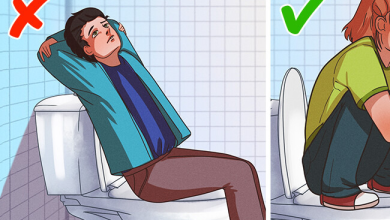Many of us are in habit of lingering a bit too long in the bathroom—scrolling through our phones, flipping through a magazine, or just savoring a few quiet minutes away from the hustle of daily life. But as per health experts, spending more than 10 minutes on the toilet could actually be harmful to your health.
In the article today, we’ll dive into the risks associated with extended toilet sessions, why you should limit your time, and some healthier bathroom habits to adopt.
The Risks of Sitting on the Toilet for Too Long
Dr. Roshini Raj, a gastroenterologist at NYU Langone, issues a warning against spending more than 10 minutes at a time on the toilet. Why? It turns out that sitting on the toilet for extended periods can lead to a range of uncomfortable and potentially serious health issues.
Hemorrhoids and Anal Pressure
One risk of prolonged toilet sitting is the increased likelihood of developing hemorrhoids. Hemorrhoids are swollen veins in the lower rectum and anus, and they can become irritated, painful, and even bleed. According to Dr. Raj, this issue arises partly because of the modern toilet’s design. When you sit on the toilet, your anorectal area—the part of your body involved in defecation—is positioned lower than the thighs. This angle allows gravity to place additional pressure on the veins in the rectum and anus, which can lead to hemorrhoid formation over time.
Muscle Strain and Pelvic Floor Issues
When you sit on the toilet for extended periods, this can also strain your pelvic muscles. These muscles play an essential role in supporting your organs and maintaining bladder and bowel control. Over time, this strain can weaken your pelvic floor, potentially leading to issues such as urinary incontinence and prolapse.
Why Using Your Phone on the Toilet Is a Bad Idea
According to a study by NordVPN, 65% of people admitted to using their phones on the toilet. While it might seem harmless, scrolling while sitting on the loo can have consequences beyond just dirtying up your screen.
Using your phone in the bathroom can make you expose to a host of germs and bacteria. Bathrooms are breeding grounds for various pathogens, and each time you touch your phone while using the toilet, you risk contaminating it with bacteria that can later transfer to your hands, face, and other surfaces. This is especially concerning given how often we use our phones. Dr. Raj highlights that many people unknowingly risk food poisoning and other illnesses due to poor hygiene practices in the bathroom. The more time you spend on the toilet with your phone, the greater your exposure to these risks.
Prolonged Sitting Time
When you bring your phone into the bathroom, you’re more likely to sit on the toilet for longer periods. You might become engrossed in a video or social media feed, losing track of time, which increases the duration you’re putting pressure on your anorectal veins. By leaving your phone outside the bathroom, you’ll be more inclined to finish up quickly, reducing the health risks associated with prolonged sitting.
How Long Should You Spend on the Toilet?

Dr. Raj advises you to keep bathroom visits under 10 minutes. If you’re spending significantly longer, it may indicate underlying issues with constipation or difficulty passing stool, which should be discussed with a healthcare provider. Prolonged bathroom time may be a signal that your diet lacks fiber or that you need to drink more water to keep your digestive system running smoothly.
What’s a Healthy Bathroom Habit?
Apart from limiting your time, there are a few simple steps you can take to promote healthier bathroom habits:
– Use a Squatting Position: A footstool that raises your feet slightly can help position your body in a way that supports natural bowel movements and reduces strain on the rectum.
– Stay Hydrated and Eat Fiber-Rich Foods: Ensuring you’re drinking enough water and consuming adequate fiber can help you avoid constipation, making your bathroom trips quicker and easier.
– Leave Your Phone Outside: Not only will this minimize distractions, but it will also encourage better hygiene and help you finish up faster.
How the Toilet’s Design Contributes to Health Issues

The typical toilet design makes contribution to the health risks associated with prolonged sitting. Unlike a natural squatting position, which opens the anorectal angle and allows for easier elimination, sitting on a standard toilet keeps this angle more closed, causing additional strain and pressure.
This is why in recent years products like footstools have become popular —they help mimic the squatting position and can make bathroom time more efficient and comfortable. If you frequently experience difficulty in the bathroom, trying a footstool may help reduce strain on your body and improve your overall experience.
By adopting simple changes—limiting your bathroom time to under 10 minutes, staying hydrated, and leaving your phone outside the bathroom—you can promote better digestive health and reduce unnecessary strain on your body. Small adjustments to your bathroom routine can make a big difference in your overall health and well-being. And besides, a little break from your phone might just give you the mental reset you need.







